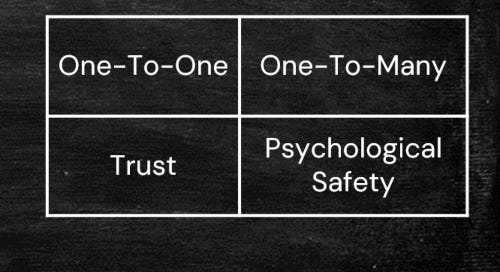Friday Forward - Safe Spaces (#454)
Psychological safety has become a huge buzzword, even though few leaders know what it means
Psychological safety has become a huge buzzword in many organizations, despite the fact that few leaders can accurately define what it means or identify whether their teams actually have it.
In my experience, psychological safety is essentially trust that is scaled up to a full group. Psychological safety expands a one-on-one trust dynamic across an entire team—everyone trusts everyone else by default. This scaled trust allows people to walk into a room with their team and feel comfortable being vulnerable, sharing concerns, and speaking the truth, without worrying about power dynamics.
However, psychological safety also requires leaders and team members to internalize that disagreement is necessary to success, mistakes won’t be punished, and tough conversations will lead to progress, rather than individual or group admonishment. This environment empowers people to bring their whole selves to work and feel comfortable speaking truth to power.
Recently, I had the privilege of facilitating a workshop for a company as part of their leadership team’s annual offsite. This company is a top performer in its space, with a great workplace reputation and numerous Best Places to Work awards. I was invited to sit in for the entire day—as a long-time admirer of this company, I was interested to see how the sausage was made, as a culture can often look good on paper but be far different in reality.
To open the offsite, each team member shared personal and professional highs and lows from the past year. I was immediately struck by the level of vulnerability in the room—a few people even had to hold back tears while recounting their most challenging or triumphant moments. No one was trying to impress or outdo each other; they were simply being human.
Shortly after, each team member was also asked “What’s the elephant in the room?” Without hesitation, people started naming the issues, and I noticed how comfortable they were speaking freely about challenges and concerns.
As expected, that same dynamic came into play as the team focused on planning the future of the business. The group didn’t shy away from difficult topics—people challenged each other, disagreed, and they pushed back on the CEO when they thought something didn’t make sense. Notably, the CEO welcomed it all.
What I saw in that room was the real definition of psychological safety in action. There was an unmistakable feeling that it was safe to be candid, even critical, because everyone was aligned around the same goal: making the business and the team better.
Unfortunately, this model of psychological safety is all too rare.
Many leaders think they have achieved psychological safety in their teams when, in reality, they are far from it. They assume that because no one is openly disagreeing or bringing up tough issues, there are none. But more often than not, silence isn’t a sign of harmony—it’s a sign of fear or hesitance based on past experiences.
If you’re unsure whether your team feels psychologically safe, here’s a great test: in your next meeting, ask your team to do something that you know is impossible. Then, see if anyone challenges you in the moment or claims that what you're asking isn’t feasible. If no one pushes back, you might not have the level of psychological safety you think you do.
Leaders often talk about wanting their teams to speak up, innovate, and push boundaries. However, that only happens if people feel safe enough to voice their thoughts without fear of negative consequences. Creating that psychologically safe environment requires consistency, openness, and a commitment to listen, even when it’s uncomfortable. These behaviors also must be modeled from the top down.
The teams that excel are those where psychological safety is embedded into the fabric of their culture. It’s what allows people to trust each other, to be vulnerable enough to deepen relationships, and to speak the truth, even in the toughest moments. Most importantly, those truths often serve to prevent poorly considered, unchecked decisions.
Quote of The Week
"Great teams do not hold back with one another. They are unafraid to air their dirty laundry. They admit their mistakes, their weaknesses, and their concerns without fear of reprisal.” - Patrick Lencioni
New For Premium Subscribers




Fantastic post. I think this is huge: "However, psychological safety also requires leaders and team members to internalize that disagreement is necessary to success, mistakes won’t be punished, and tough conversations will lead to progress, rather than individual or group admonishment." Getting into that habit of having those tough conversations and building the skill of approaching them in the right way takes a lot of practice and study, at least for me. Appreciate you sharing!
Nice article Robert. This paragraph really stood out: "Many leaders think they have achieved psychological safety in their teams when, in reality, they are far from it. They assume that because no one is openly disagreeing or bringing up tough issues, there are none. But more often than not, silence isn’t a sign of harmony—it’s a sign of fear or hesitance based on past experiences." It's so hard to see through this because false consensus bias, illusion of transparency, and confirmation bias are all working together to cloud the leaders judgement.